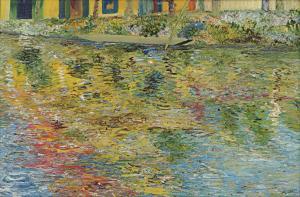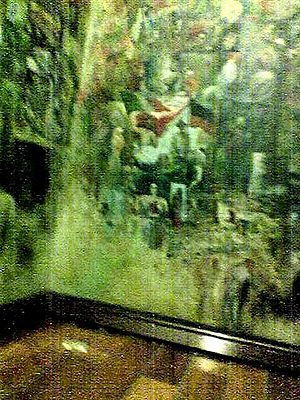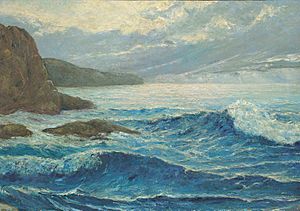Joaquín Clausell facts for kids
Joaquín Quirico Marcelino Clausell Traconis (born June 16, 1866 – died November 28, 1935) was a famous Mexican lawyer and activist. He is best known for his beautiful Impressionist paintings of Mexico's landscapes and seascapes. Joaquín was born and grew up in the city of Campeche. He started drawing when he was a young student.
Later, he had to leave Campeche and move to Mexico's capital after a disagreement with the governor. In Mexico City, he studied law, even though he was very poor. He often spoke out against the government, which sometimes got him into trouble and even jail. After finishing his studies, he worked as a journalist for newspapers that opposed the government. In 1893, he had to leave Mexico and went to the United States and then to Paris. In Paris, he discovered the Impressionist art style, which he loved. However, he didn't start painting his own works until he returned to Mexico.
Clausell painted during two main periods: from the early 1900s and again from 1920 until he died. He stopped painting during the Mexican Revolution. His paintings on canvas are mostly landscapes and seascapes, following the Impressionist style. He also created many unique paintings on the walls of his studio. These studio works show more variety in themes and styles. Even though he wasn't a central figure in Mexico's art world during his life, famous artists like Diego Rivera and Dr. Atl admired his work. Since 1995, after a special event at Mexico's National Art Museum, his art has become much more recognized.
Contents
Joaquín Clausell's Life Story
Joaquín Clausell was the son of José Clausell, who came from Catalonia (now in Spain), and Marcelina Franconis, from Campeche. His father first came to Mexico to work in shipbuilding. Later, he became a businessman in the city of Campeche. Joaquín was born on June 16, 1866, and was their only child. The family story says they gave him many names because they didn't expect to have more children.
His family was well-off, so Joaquín could attend a private school called the Instituto Campechano. However, his father passed away, and Joaquín had to work while studying to help his family.
Early Rebellious Spirit
From a young age, Joaquín had a rebellious personality. Once, as an altar boy, he used his red church robe for a Carnival costume. This led to him being banned from his religious role. This rebellious nature also made him speak out against the government of Porfirio Díaz. When he was 16, he publicly challenged the governor of Campeche, Joaquín Baranda. This led to him being expelled from school and having to leave the state.
Clausell moved to Mexico City with very little money. He started working odd jobs, like cleaning equipment at a pharmacy, just to survive. In the capital, he met many young people, both rich and poor, who shared his liberal ideas and opposed the government.
Studying Law and Facing Challenges
Clausell briefly attended the National School of Engineers, but he was more interested in law. He found ways to borrow law books from the National Law School library to study at night. He was caught doing this and was put in jail. However, the dean of the law school visited him. The dean was impressed by Clausell's strong desire to learn despite his poverty. He offered Clausell admission and a scholarship to the law school. Still, Clausell had to work many small jobs to support himself. He even pawned a medal he won in a debate to buy food.
Studying law did not stop his political activities. He was a great speaker and organizer. In 1889, he helped organize students to honor Sebastián Lerdo de Tejada, a political exile whose body was being returned to Mexico. The government tried to keep the event quiet, but Clausell spoke out, supporting Lerdo de Tejada's ideas. He was arrested for speaking against the government and spent several months in the Belem Prison. Even though he finished all his law classes by 1892, his time in jail prevented him from taking the final exam and getting his law degree right away.
Exile and Return
Clausell's work as a journalist later got him into political trouble again. This forced him to leave Mexico and go into exile, first to the United States and then to Paris. He stayed in touch with friends and family through letters, sometimes using fake names.
While in Paris, Clausell discovered the Impressionism art movement. He was especially impressed by the paintings of Camille Pissarro. Clausell became friends with Pissarro and visited his studio several times. There is no clear evidence that Clausell started painting or took art classes while he was in Europe.
Clausell returned to Mexico City in 1896. He reconnected with writers, journalists, and artists of the time. He was finally able to take his bar exam and received his law degree in 1901. Interestingly, his degree was signed by President Porfirio Díaz himself.
Family Life and Studio
Around this time, he married Angela Cervantes. Her brother, Antonio Cervantes, had helped Clausell financially during his exile. Angela's family was from a noble background and still had some wealth. Clausell moved into their family home, which is now the Museum of the City of Mexico. Angela later inherited the mansion. Joaquín and Angela had four children: Angela, Dolores, Estella, and Joaquín.
Angela didn't fully approve of Clausell's painting or some of his friends. So, two rooms were built for him on the roof of the mansion. One of these became his studio. This studio was a large room with doors and windows on three sides, earning it the nickname "tower of a thousand windows." Clausell used his studio as a quiet escape from his wife and her family. He also entertained friends there, including Dr. Atl, Juan O'Gorman, Diego Rivera, Carlos Pellicer, Salvador Novo, and Julio Ruelas. They would discuss new and modern ideas. In 1908, Dr. Atl even created a portrait of Clausell.
Clausell also painted directly on the walls of his studio. He filled them with sketches and paintings at different stages, without a specific plan. There are about 1,300 of these works, in various sizes. They are different from his canvas landscapes because they show a wider range of themes and styles beyond Impressionism. These murals have not been widely seen because the studio has often been closed to the public due to its condition.
Even with his famous friends, Clausell was not a central figure in the Mexican art scene. His closest friend was Dr. Atl. Clausell was also a Freemason.
His Passing
Joaquín Clausell died on November 28, 1935. He was on an outing with friends and family near the Lagos de Zempoala area, south of Mexico City. He was walking on a hill when the ground gave way, and he fell down an embankment. A landslide covered him, and he passed away.
Clausell's Public Life
While Clausell is most famous for his paintings, he was also a speaker, journalist, and lawyer. He continued to oppose the Díaz government after he finished law school, especially through journalism.
He first worked for El Universal newspaper, writing articles that criticized the government under the pen name Juan Pérez. However, government pressure soon ended this job. He then tried to start his own publication, La Soberanía de los Estados, but it failed due to lack of money. He also wrote for other newspapers like El Hijo del Ahuizote and El Monitor Republicano.
Soon after Díaz was re-elected for a third time, Clausell helped start an opposition newspaper called El Demócrata in 1893, and he also managed it. Months later, the paper published parts of a fictional story about the army's fight against the Tarahumara people in Chihuahua. This led to him and his co-founder being sent back to Belem Prison. Just before his trial, Clausell escaped and, with the help of friends, went into exile in the United States and France.
By the start of the Mexican Revolution, Clausell supported Francisco I. Madero's political party. We don't know much about what role Clausell played in the conflict, especially after Madero was killed. We do know that during the 1910s, he worked as a lawyer, often defending poor people in the prisons of Xochimilco. He usually did this work for free or accepted whatever his clients could pay him, which was often farm products. This earned him the nickname "Abogado Gallina" (Lawyer Chicken).
Joaquín Clausell's Artistry
It is thought that Clausell created about 400 paintings during his lifetime, with about 100 of them being large. However, he didn't sign his works and rarely dated them, which makes it hard to keep track of them or know when they were painted. He didn't see himself as a professional painter. He was a private person and didn't promote his art. With a few exceptions, he didn't spend much time with other Mexican artists of his time.
There's no known connection between Clausell and the older landscape artist José María Velasco, who was famous for his paintings of the Valley of Mexico. Clausell rarely sold his works and often gave them away. However, he did teach art at "escuelas de aire libre" (free art classes held in parks). He worked with Dr. Atl and became the director of the school in Iztacalco in 1930.
His Painting Style
While he drew cartoons as a young student, his interest in painting truly grew in Paris. He saw an exhibition of Camille Pissarro's work in 1896, and it deeply impressed him. Clausell is generally considered to have taught himself how to paint. Some art historians believe he might have had some formal training, but there are no records of him attending art schools in Paris or Mexico City. Also, his personal papers and family stories don't mention any such studies. However, some of his early works, which are copies of other painters' art, suggest he might have been learning. One of his oldest known works is a copy of a painting by Edith Corbet, which Clausell dedicated to Van Gogh, Cezanne, and Monet.
Clausell had two main periods of painting. The first was from about 1903 to 1910, and the second was from 1920 until his death in 1935. He stopped painting during the Mexican Revolution, likely to focus on his law practice. His painting was most intense in the later period. It became almost like a strong habit for him. All his extra money went to art supplies, and he even painted on wood and cardboard when he didn't have canvas. Sometimes, he would disappear to Mexico's coasts, especially between Mazatlán and Acapulco. He would return with sketches that he used as ideas for new paintings.
Most of Clausell's works are oil paintings, though he also did some watercolors. He painted on canvas, wood, and cardboard. His colors often look like pastels, and he applied paint mostly with brushes, sometimes using a spatula. Most of his work is clearly Impressionist. He openly admired the works of Van Gogh, Renoir, Cezanne, and Monet. His paintings show influences from all these artists, as well as Camille Pissarro and Alfred Sisley. While his canvas works stick to the original Impressionist style, he did experiment with the colors of clouds, sky, rivers, and the sea, making them more vibrant than they appear in nature.
Unlike many Impressionist painters, Clausell was not very interested in showing people's daily lives. People rarely appear in his paintings. Instead, his art was inspired by Mexico's natural beauty, especially in places like Tlalpan and the lake areas of Iztacalco and Xochimilco, along with the Pacific Coast. While Mexico has had many great landscape artists, Clausell's work stands out because of his strong dedication to Impressionism. This style continued even as the Mexican muralism movement began. However, the social themes of the muralists did not influence Clausell.
Unlike the wide, sweeping views in José María Velasco's paintings, Clausell's works show the Valley of Mexico in smaller, more personal scenes. Many of these scenes are from areas connected to his family's lands or from trips with Dr. Atl. A significant number of his paintings show Iztacalco and the Santa Anita Canal, which existed then, as well as his wife's family ranch. According to art historian Xavier Moyssen, Clausell was the best among his peers at painting seascapes. One special painting is Ola verde (Green Wave), which captures the green waves of the Laguna de Cuyutlán.
Most of his canvas works have traditional colors and subjects. However, the paintings he created on his studio walls are different. They show more experimentation and a wider range of themes. These works have received less attention from the public and art critics, mainly because they are not easily accessible.
Recognition and Legacy
Since his death in 1935, Joaquín Clausell has been recognized as Mexico's most important Impressionist artist. Even though he didn't introduce the style to the country, his work was noticed and praised by many well-known artists during his lifetime. In a 1921 exhibition, his paintings caught the eye of Diego Rivera, who had just returned from Europe. Rivera later visited Clausell in his studio. This was notable because Rivera's generation often looked down on "academic" and European painting styles. Rivera called Clausell the best landscape artist in Mexico and a "painter-poet" who captured the country's natural beauty. Dr. Atl also strongly supported and promoted Clausell's work.
Clausell's paintings were only shown occasionally during his lifetime, usually as part of group exhibitions. One of his works was bought from an exhibition by the Ministry of Public Education and Fine Arts for the gallery of the Academy of San Carlos.
After his death, many important art critics and historians have written about his work. Critic Jorge Juan Crespo de la Serna wrote about him in 1945. Justino Fernandez included him in a major book about 19th-century Mexican art. In 1995, the National Art Museum of Mexico held a special tribute and exhibition for Clausell. They also published a book about him.
His granddaughter, Patricia Clausell de Latapí, has also worked to document and protect his art. In 2008, she published a book called Nostalgia ocultas: Anécdotas sobre la vida de Joaquín Clausell (Hidden Nostalgias: Anecdotes about the life of Joaquín Clausell). One reason for the book is that more than seventy fake Clausell paintings have been found. However, she admits that a complete list of his works is difficult to create because he didn't sign or date his paintings, and they are spread out in many private collections.
In 2012, one of Clausell's paintings, Iglesia de San Ángel (Church of San Ángel), was sold for 360,000 pesos.
To honor Clausell and recognize him as a pioneer of modern art in Mexico, a painting competition called the Bienal de Pintura Joaquín Clausell (Biennial of the Painter Joaquín Clausell) has been held since 1993. It is sponsored by the National Council for Culture and Arts, the Ministry of Culture of the State of Campeche, and the Autonomous University of Campeche.
Images for kids
See also
 In Spanish: Joaquín Clausell para niños
In Spanish: Joaquín Clausell para niños








